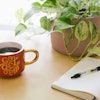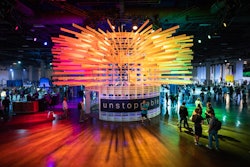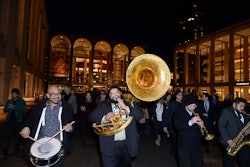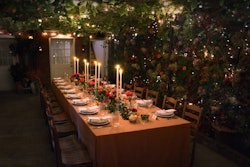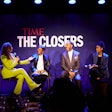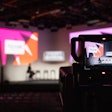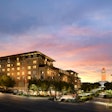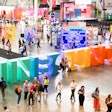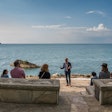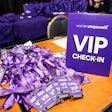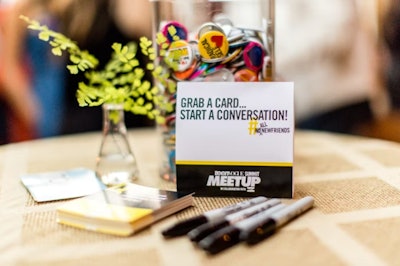
“Contrary to what the alcohol industry may want you to think, tossing an open bar into your event won’t magically spark engaging conversations and foster genuine relationships,” points out Brad Rankin, senior solutions architect at Opus Agency.
As we hear over and over, the most valuable events focus on community and connection above all—but just getting the right people in the right room is only half the battle. So how exactly do you help your attendees get the most out of those valuable face-to-face connections?
“Identify the shared heart and emotion of the target demographic(s) and use that as the north star for designing the experience and guest journey,” suggests Cathryn Garcia-Menocal, design director of Pink Sparrow. “Creating community at an event is about identifying the underlying similarity across the different demographics of attendees and making that the emotional centerpiece of the event.”
There are some tried-and-true methods for making guests feel connected, ranging from the classic icebreakers and social media groups to small-group breakouts and tech-driven matchmaking services. The key is, of course, tailoring to your specific audience, explains Leah Taylor Dunbar, creative director of MKG. “So, while there are some best practices that we’ve honed over the years here at MKG, what makes our experiences really pop for attendees is our attention to the needs, wants, and lifestyle of our target. And that changes with every brief!”
To spark inspiration, we asked event professionals to share some of the more unexpected ways they've gotten guests interacting.
On-Site Activities
Leah Taylor Dunbar, creative director, MKG: “Building in 'side quests' for guests gives them something to do besides sip the custom cocktail they got upon arrival. And creating together is an amazing way to foster connection. We’ve found success with everything from DIY friendship bracelets and phone charms to airbrushing, perfume-making, and scavenger hunts. Again, it’s all about knowing the brand and your audience, and finding activities that will appeal to both.”Darcy Gabriele, sales director, BW Events Tech: "My No. 1 favorite networking activation I've ever seen was at the CEMA-Corporate Event Marketing Association Summit a few years back. They hosted a salsa-making competition. We were broken up into small groups of five or six, and we had to work together to make a unique salsa from a wide array of provided ingredients, then name our product and develop a little marketing campaign for it. It was so fun; I am still friends with the folks in my salsa group to this day!"
Lauren Cleland, vice president of strategic marketing, Visit Savannah: "We've found that hands-on activities and sensory experiences are key. For example, during our 'Surprisingly Savannah Mobile Tour,' we incorporated touchpoints like a photo booth, a make-your-own salt scrub station, honey tastings, trivia with giveaways, and live music. These elements not only draw people in but also serve as conversation starters, sparking curiosity and engagement."  “Attendees are looking for immersive experiences, not just passive information,” says Cleland. “So, our focus is always on creating moments that are both engaging and shareable, fostering a sense of community and excitement around the event."Photo: Courtesy of Visit Savannah
“Attendees are looking for immersive experiences, not just passive information,” says Cleland. “So, our focus is always on creating moments that are both engaging and shareable, fostering a sense of community and excitement around the event."Photo: Courtesy of Visit Savannah
Off-Site Activities
Andrew Roby, corporate event planner, Andrew Roby Events: "One thing that I am seeing an increase in is off-site experiences taking place during multiday events. This can be cooking classes, painting, community service, hiking, tours including popular venues, and much more. These off-site events can shape themselves into team-building opportunities that allow various people who share common interests to find themselves in the midst of hundreds or even thousands of people. The goal is to ensure people know about this during registration so that it is more intentional and you reach the desired outcome."Carefully Planned Session Breaks
Alicia Jenelle, director of experiential event production, The Jenelle Group Inc.: "Introduce 'Analog Creativity Sessions' as a refreshing brain-break activity that completely disconnects from social media and digital screens. These sessions focus on hands-on, interactive experiences that encourage creativity and relaxation without relying on digital engagement."Kacie Hogan, senior director of events, iCIMS: “Incorporate a charity and/or team-building activity into your breaks. Networking breaks are great, but without providing structure and encouragement to your attendees, these could often lead to a quick email check back in their hotel room—and you’ve now missed a great opportunity to build attendee connections. Incorporating a team-building challenge is a great way to get folks working together and having some fun. Bonus points if it also gives back to a great cause! Some suggestions can include putting together food baskets for a nearby shelter, assembling bicycles to donate to kids, or doing a nearby beach cleanup.”
Conversation-Sparking Badges
Alyssa Balzotti, director of incentive events and recognition, Rodan + Fields: "During registration, we asked them for five words that described them (example: hiker) and then printed those on name badges. It was a comfortable way for people to start conversations like, “Oh, hey, I see you’re a coffee lover too. There’s a coffee shop around the corner—we should grab one.'"Kacie Hogan: “Offer special buttons/ribbons that attendees can attach to their name badges upon arrival highlighting what they are passionate about. This allows folks to engage in conversation more naturally and find folks they have in common with while walking the expo floor or sitting in theater sessions.”
Unique Venues
Brad Rankin, senior solutions architect, Opus Agency: “Use the space as a tool. Unique venues serve as great conversation starters. Juxtapose your future-forward tech conference with a historical venue in the heart of London. Pull inspiration from C2 Montreal's iconic suspended networking chairs. Encouraging a sense of wonder or risk can persuade individuals to foster deeper connections and bond outside their comfort zones.”Cathryn Garcia-Menocal, design director, Pink Sparrow: “An event we designed for Marantz (the audio equipment company) had a very diversified target audience, including musicians, composers, academics, audiophiles, tastemakers, engineers, etc.—and the common thread between all individuals was that they would be moved by the luxurious sound. So, we disrupted the idea of a 'listening room' by creating a space (exclusively in the brand color, in a variety of textures) that suppressed all visible audio equipment—a tough sell for a client wanting to increase sales of audio equipment! By stripping the experience down to color, light, and sound, instead of making it a typical listening room with an equipment demo/living room set piece, we were able to successfully connect our varied audience members.”
Clever Transition Moments
Lucy Montoya Roberts, trade shows and events, Epson America Inc.: "I had a one-day roadshow followed by an evening dinner in the next ballroom. I needed to get everyone off the show floor quickly and into the dinner. I hired conga dancers and musicians who started a conga line, and people joined in to dance their way off the show floor. We could start dismantling in 20 minutes, and it also was great to start the evening festivities. I don’t know if this would work everywhere, but I was in Miami and it was a great place to try it!"
Brad Rankin: “Don’t underestimate the value of connections made in passing between sessions. Design fun transitions to move attendees from space to space. We’ve used a mariachi band to lead attendees from the keynote to the expo hall. Secret doors or mysterious signage that lead to unknown spaces offer surprise-and-delight moments for attendees to chat about. This creates natural connections that continue throughout the event."
Thoughtful Conversational Prompts
Kaitlyn Dineen, president and owner, Fifth Street DMC: "The team at Fifth Street DMC just did centerpieces inspired by Table Topics, with questions for the group to ask each other over breakfast. It was simple to execute and cost-effective. You could make the questions about subject matter discussed in the conference, the city, or just general get-to-know-you questions. Those meals are always so awkward, and the feedback was that this really helped break the ice and attendees felt better equipped to engage and start the conversation."Leah Taylor Dunbar: “Networking can be rough! Make it easier on your attendees with integrated conversation starters. Maybe these are facts or trivia relevant to your audience or event on tabletop cards; maybe it’s a projection or video display. You’ve done the work to build an amazing experience and get folks there; make sure they have something to talk about besides the weather.”
Strategic Seating Arrangements & Networking Sessions
Kacie Hogan: "‘Birds of a Feather’ meals: Arrange lunch seating for your guests based on topics that they have in common—some easy ones to start with include industry-based or size of company, but I find we get even more engagement when we create topics around business challenges that they are facing or even more personal/fun categories such as ‘Women in Tech’, ‘Travel Gurus’, ‘Foodies,’ etc."Alicia Jenelle: "Set up themed areas based on industry topics or interests. At a marketing summit, we had zones like 'The Marketing Funnel' and 'Positive Change.' This not only helped in targeted networking, but also made attendees feel more comfortable starting conversations within their interest areas."
Brad Rankin: “Similar to speed dating, plan a fast-paced speed-networking session. Set up small tables with numbered stations and assign pairs or trios to each station for a three- or four-minute business date. Provide a unique topic for each table, and then have attendees rotate tables to keep the introductions happening and the conversations flowing. Ideally, they’ll continue their conversations throughout the event."

